2009 Hyundai Santa Fe air condition
[x] Cancel search: air conditionPage 128 of 269
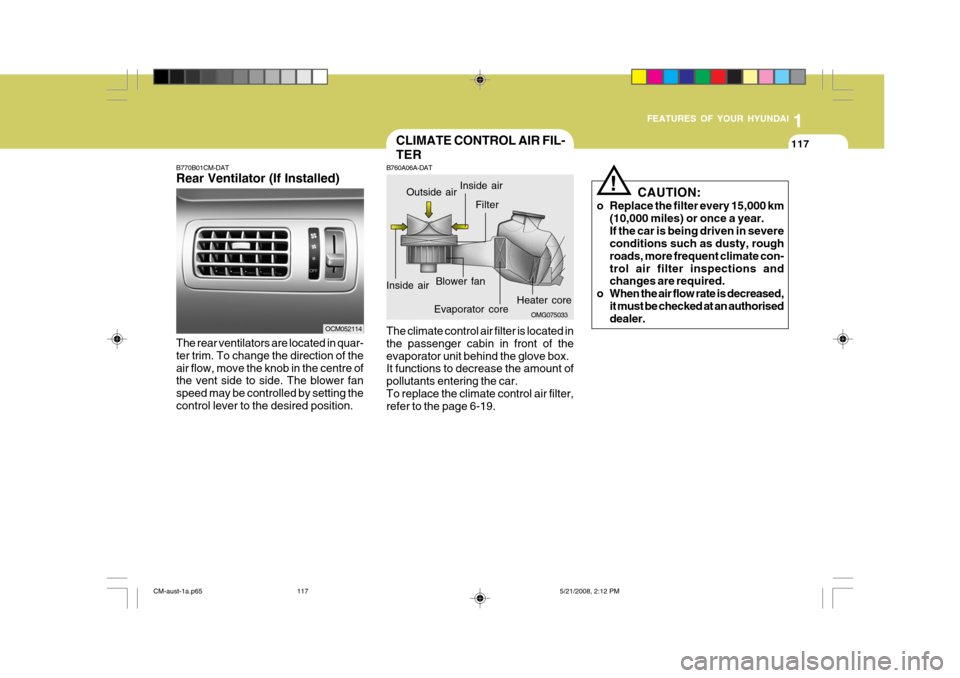
1
FEATURES OF YOUR HYUNDAI
117
B770B01CM-DAT Rear Ventilator (If Installed) The rear ventilators are located in quar- ter trim. To change the direction of theair flow, move the knob in the centre of the vent side to side. The blower fan speed may be controlled by setting thecontrol lever to the desired position.
OCM052114
CLIMATE CONTROL AIR FIL- TER
B760A06A-DAT The climate control air filter is located in the passenger cabin in front of theevaporator unit behind the glove box. It functions to decrease the amount of pollutants entering the car.To replace the climate control air filter, refer to the page 6-19.
OMG075033
Inside air
Blower fan
Evaporator core Filter
Outside air
Heater core
Inside airCAUTION:
o Replace the filter every 15,000 km (10,000 miles) or once a year. If the car is being driven in severe conditions such as dusty, rough roads, more frequent climate con-trol air filter inspections and changes are required.
o When the air flow rate is decreased,
it must be checked at an authoriseddealer.!
CM-aust-1a.p65 5/21/2008, 2:12 PM
117
Page 167 of 269
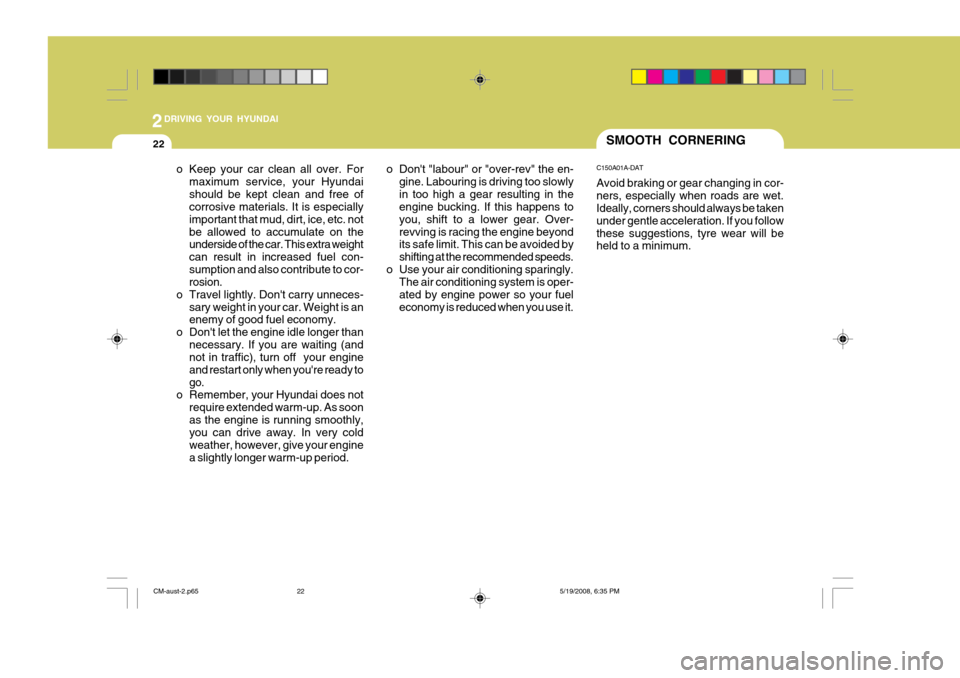
2DRIVING YOUR HYUNDAI
22SMOOTH CORNERING
C150A01A-DAT Avoid braking or gear changing in cor- ners, especially when roads are wet. Ideally, corners should always be taken under gentle acceleration. If you followthese suggestions, tyre wear will be held to a minimum.
o Don't "labour" or "over-rev" the en-
gine. Labouring is driving too slowly in too high a gear resulting in the engine bucking. If this happens to you, shift to a lower gear. Over-revving is racing the engine beyond its safe limit. This can be avoided by shifting at the recommended speeds.
o Use your air conditioning sparingly. The air conditioning system is oper-ated by engine power so your fueleconomy is reduced when you use it.
o Keep your car clean all over. For
maximum service, your Hyundaishould be kept clean and free of corrosive materials. It is especially important that mud, dirt, ice, etc. notbe allowed to accumulate on the underside of the car. This extra weight can result in increased fuel con-sumption and also contribute to cor- rosion.
o Travel lightly. Don't carry unneces- sary weight in your car. Weight is anenemy of good fuel economy.
o Don't let the engine idle longer than
necessary. If you are waiting (andnot in traffic), turn off your engine and restart only when you're ready togo.
o Remember, your Hyundai does not
require extended warm-up. As soonas the engine is running smoothly, you can drive away. In very cold weather, however, give your enginea slightly longer warm-up period.
CM-aust-2.p65 5/19/2008, 6:35 PM
22
Page 174 of 269
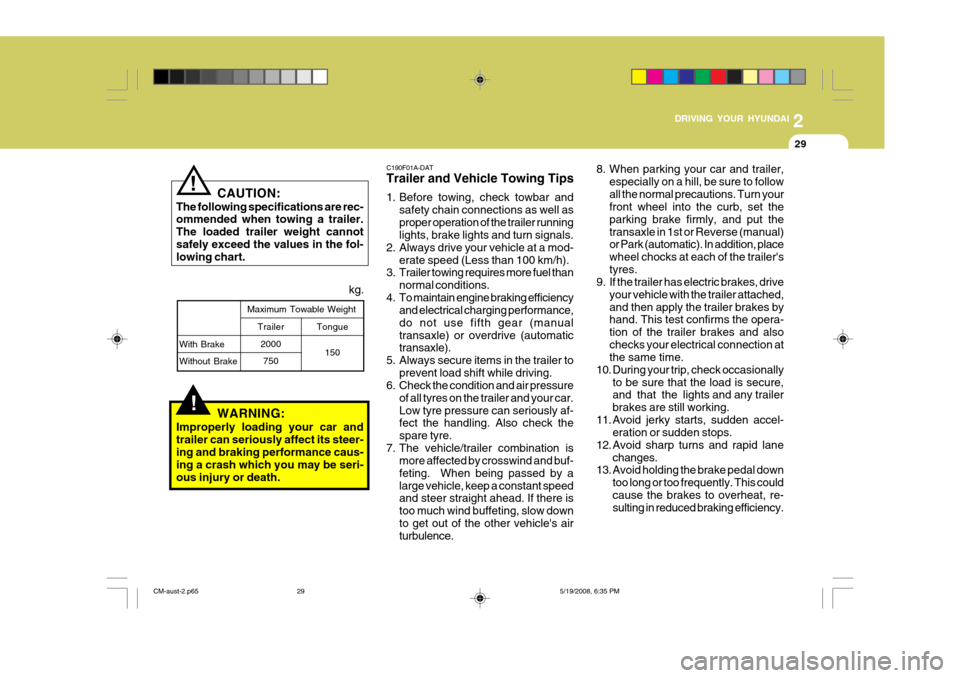
2
DRIVING YOUR HYUNDAI
29
!
C190F01A-DAT Trailer and Vehicle Towing Tips
1. Before towing, check towbar and
safety chain connections as well as proper operation of the trailer running lights, brake lights and turn signals.
2. Always drive your vehicle at a mod- erate speed (Less than 100 km/h).
3. Trailer towing requires more fuel than
normal conditions.
4. To maintain engine braking efficiency and electrical charging performance, do not use fifth gear (manualtransaxle) or overdrive (automatic transaxle).
5. Always secure items in the trailer to prevent load shift while driving.
6. Check the condition and air pressure
of all tyres on the trailer and your car. Low tyre pressure can seriously af- fect the handling. Also check the spare tyre.
7. The vehicle/trailer combination is more affected by crosswind and buf-feting. When being passed by alarge vehicle, keep a constant speed and steer straight ahead. If there is too much wind buffeting, slow downto get out of the other vehicle's air turbulence. 8. When parking your car and trailer,
especially on a hill, be sure to follow all the normal precautions. Turn your front wheel into the curb, set the parking brake firmly, and put thetransaxle in 1st or Reverse (manual) or Park (automatic). In addition, place wheel chocks at each of the trailer'styres.
9. If the trailer has electric brakes, drive
your vehicle with the trailer attached,and then apply the trailer brakes by hand. This test confirms the opera- tion of the trailer brakes and alsochecks your electrical connection at the same time.
10. During your trip, check occasionally to be sure that the load is secure,and that the lights and any trailer brakes are still working.
11. Avoid jerky starts, sudden accel- eration or sudden stops.
12. Avoid sharp turns and rapid lane changes.
13. Avoid holding the brake pedal down
too long or too frequently. This couldcause the brakes to overheat, re- sulting in reduced braking efficiency.
CAUTION:
The following specifications are rec-ommended when towing a trailer. The loaded trailer weight cannotsafely exceed the values in the fol- lowing chart.
!
Maximum Towable Weight kg.
With Brake Without Brake
WARNING:
Improperly loading your car and trailer can seriously affect its steer-ing and braking performance caus- ing a crash which you may be seri- ous injury or death.
Tongue
150
Trailer
2000750
CM-aust-2.p65 5/19/2008, 6:35 PM
29
Page 175 of 269
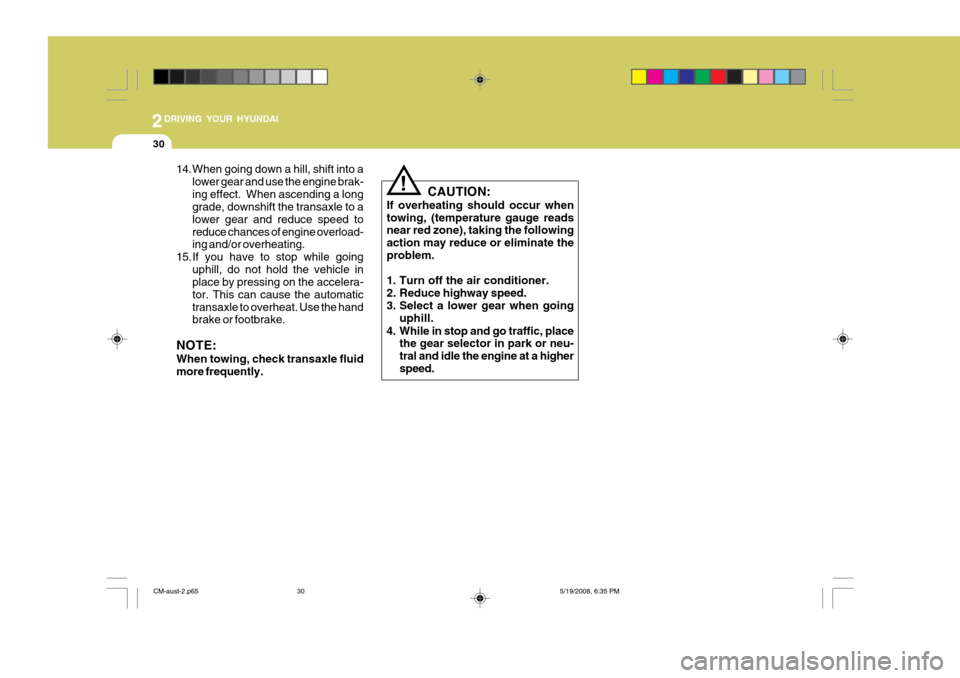
2DRIVING YOUR HYUNDAI
30
CAUTION:
If overheating should occur when towing, (temperature gauge reads near red zone), taking the following action may reduce or eliminate theproblem.
1. Turn off the air conditioner.
2. Reduce highway speed.
3. Select a lower gear when going uphill.
4. While in stop and go traffic, place the gear selector in park or neu-tral and idle the engine at a higher speed.
!
14. When going down a hill, shift into a
lower gear and use the engine brak- ing effect. When ascending a long grade, downshift the transaxle to a lower gear and reduce speed toreduce chances of engine overload- ing and/or overheating.
15. If you have to stop while going uphill, do not hold the vehicle inplace by pressing on the accelera- tor. This can cause the automatictransaxle to overheat. Use the hand brake or footbrake.
NOTE: When towing, check transaxle fluid more frequently.
CM-aust-2.p65 5/19/2008, 6:35 PM
30
Page 179 of 269
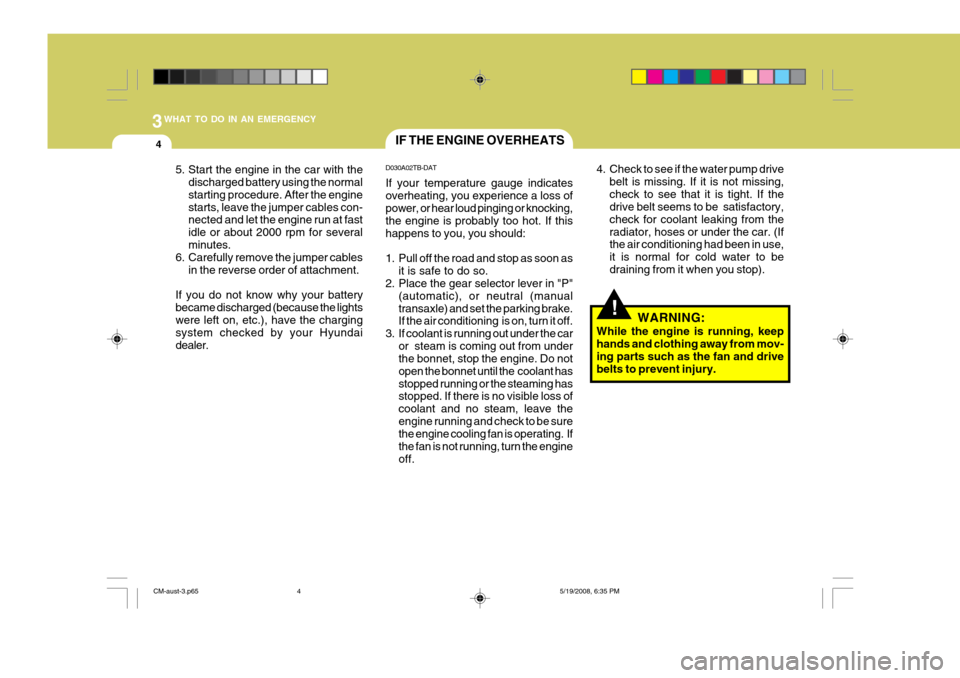
3WHAT TO DO IN AN EMERGENCY
4
!
IF THE ENGINE OVERHEATS
4. Check to see if the water pump drivebelt is missing. If it is not missing, check to see that it is tight. If the drive belt seems to be satisfactory, check for coolant leaking from theradiator, hoses or under the car. (If the air conditioning had been in use, it is normal for cold water to bedraining from it when you stop).
D030A02TB-DAT If your temperature gauge indicates overheating, you experience a loss of power, or hear loud pinging or knocking, the engine is probably too hot. If thishappens to you, you should:
1. Pull off the road and stop as soon as
it is safe to do so.
2. Place the gear selector lever in "P"
(automatic), or neutral (manual transaxle) and set the parking brake. If the air conditioning is on, turn it off.
3. If coolant is running out under the car or steam is coming out from underthe bonnet, stop the engine. Do not open the bonnet until the coolant hasstopped running or the steaming has stopped. If there is no visible loss of coolant and no steam, leave theengine running and check to be sure the engine cooling fan is operating. If the fan is not running, turn the engineoff. WARNING:
While the engine is running, keephands and clothing away from mov-ing parts such as the fan and drive belts to prevent injury.
5. Start the engine in the car with the
discharged battery using the normal starting procedure. After the enginestarts, leave the jumper cables con- nected and let the engine run at fast idle or about 2000 rpm for severalminutes.
6. Carefully remove the jumper cables
in the reverse order of attachment.
If you do not know why your batterybecame discharged (because the lightswere left on, etc.), have the charging system checked by your Hyundai dealer.
CM-aust-3.p65 5/19/2008, 6:35 PM
4
Page 191 of 269
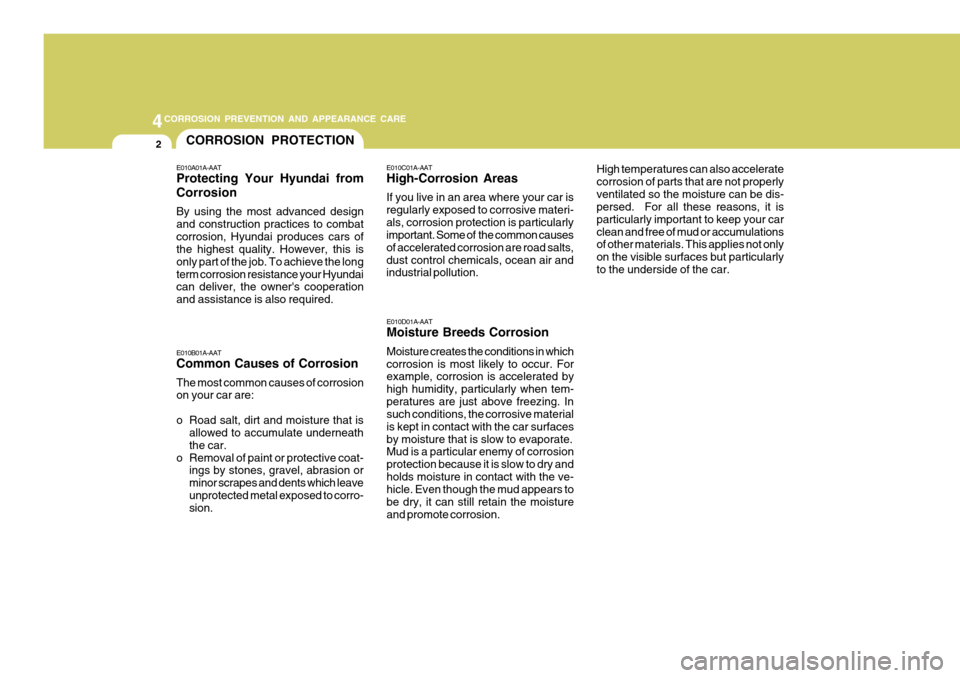
4CORROSION PREVENTION AND APPEARANCE CARE
2CORROSION PROTECTION
E010A01A-AAT Protecting Your Hyundai from Corrosion By using the most advanced design and construction practices to combatcorrosion, Hyundai produces cars of the highest quality. However, this is only part of the job. To achieve the longterm corrosion resistance your Hyundai can deliver, the owner's cooperation and assistance is also required. E010C01A-AAT High-Corrosion Areas If you live in an area where your car is regularly exposed to corrosive materi-als, corrosion protection is particularly important. Some of the common causes of accelerated corrosion are road salts,dust control chemicals, ocean air and industrial pollution.
E010B01A-AAT Common Causes of Corrosion The most common causes of corrosion on your car are:
o Road salt, dirt and moisture that is allowed to accumulate underneath the car.
o Removal of paint or protective coat- ings by stones, gravel, abrasion orminor scrapes and dents which leaveunprotected metal exposed to corro- sion. E010D01A-AAT Moisture Breeds Corrosion Moisture creates the conditions in which corrosion is most likely to occur. For example, corrosion is accelerated by high humidity, particularly when tem-peratures are just above freezing. In such conditions, the corrosive material is kept in contact with the car surfacesby moisture that is slow to evaporate. Mud is a particular enemy of corrosion protection because it is slow to dry andholds moisture in contact with the ve- hicle. Even though the mud appears to be dry, it can still retain the moistureand promote corrosion. High temperatures can also acceleratecorrosion of parts that are not properlyventilated so the moisture can be dis- persed. For all these reasons, it is particularly important to keep your carclean and free of mud or accumulations of other materials. This applies not only on the visible surfaces but particularlyto the underside of the car.
Page 200 of 269

5VEHICLE MAINTENANCE REQUIREMENTS
4REGULAR SERVICING
F030A03A-DAT An odometer reading or time interval determines when service is necessary. For most people, the odometer reading will indicate when service is needed. If, however, you drive very little, your vehicle should be serviced at least every 12 months. Under severe driving conditions, more frequent maintenance is required.
See Note (3) See Note (5)
NO.
12 3 4 5 6 7 8 9
1011
F030B04CM-DAT R :Replace I : Inspect and, after Inspection, clean, adjust, repair or replace of necessary.
105
84
R I I I I 120
96
R I
R I II I
9072
R I I I I
RR
75 60
R I I I I
60 48
R I
R I II I
45 36
R I I I
R R
30 24
R I I II I
15 12
R I I I I
KILOMETERS X 1000 MONTHS DESCRIPTION ENGINE CONTROL SYSTEM MAINTENANCE (PETROL) ENGINE OIL & FILTER
DRIVE BELT
2.7 V6
(AUTO-TENSIONER, ALTERNATOR, P/STR'G, A/CON) 3.3 V6FUEL FILTER (MPI TYPE) FUEL LINES, FUEL HOSES & CONNECTIONS TIMING BELT (2.7 V6 only) VAPOR HOSE & FUEL FILLER CAP CRANKCASE VENTILATION HOSES AIR CLEANER FILTER FUEL TANK AIR FILTER (if installed)
VALVE CLEARANCE See Note (4)SPARK PLUG (IRIDIUM COATED)
NOTE: (1) EVERY 48,000 KM OR 24 MONTHS : "I" (2) INSPECT EVERY 60,000 KM AND REPLACE EVERY
120,000 KM OR 60 MONTHS.
(3) EVERY 96,000 KM OR 48 MONTHS : "I"
See Note (2)
See Note (1)
(4) INSPECT FOR EXCESSIVE TAPPET NOISE AND/OR ENGINE VIBRATION AND ADJUST IF NECESSARY.
(5) EVERY 160,000 KM : "R"
CM-aust-5.p65 5/19/2008, 6:37 PM
4
Page 202 of 269
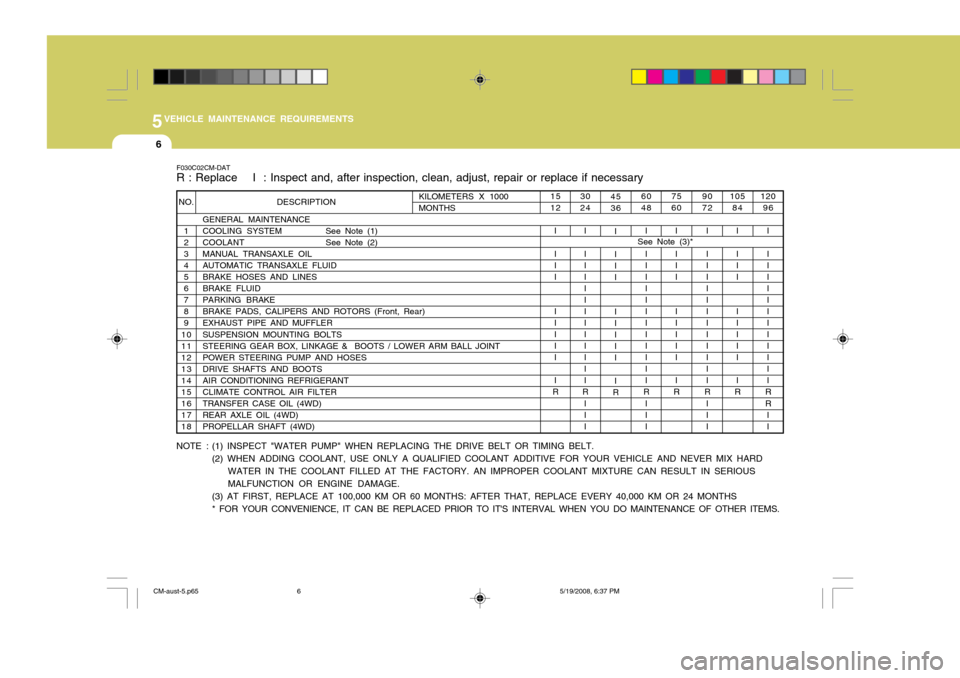
5VEHICLE MAINTENANCE REQUIREMENTS
6
F030C02CM-DAT R : Replace I : Inspect and, after inspection, clean, adjust, repair or replace if necessary
NOTE : (1) INSPECT "WATER PUMP" WHEN REPLACING THE DRIVE BELT OR TIMING BELT. (2) WHEN ADDING COOLANT, USE ONLY A QUALIFIED COOLANT ADDITIVE FOR YOUR VEHICLE AND NEVER MIX HARD
WATER IN THE COOLANT FILLED AT THE FACTORY. AN IMPROPER COOLANT MIXTURE CAN RESULT IN SERIOUS MALFUNCTION OR ENGINE DAMAGE.
(3) AT FIRST, REPLACE AT 100,000 KM OR 60 MONTHS: AFTER THAT, REPLACE EVERY 40,000 KM OR 24 MONTHS * FOR YOUR CONVENIENCE, IT CAN BE REPLACED PRIOR TO IT'S INTERVAL WHEN YOU DO MAINTENANCE OF OTHER ITEMS. 75 60
I I II I I III I
R 90 72
I I IIIII I IIIII
R
III
1512
I I II I I III I
R See Note (3)*
DESCRIPTION
GENERAL MAINTENANCE
COOLING SYSTEM See Note (1)COOLANT See Note (2)
MANUAL TRANSAXLE OIL AUTOMATIC TRANSAXLE FLUID BRAKE HOSES AND LINESBRAKE FLUIDPARKING BRAKEBRAKE PADS, CALIPERS AND ROTORS (Front, Rear)EXHAUST PIPE AND MUFFLER SUSPENSION MOUNTING BOLTS STEERING GEAR BOX, LINKAGE & BOOTS / LOWER ARM BALL JOINTPOWER STEERING PUMP AND HOSESDRIVE SHAFTS AND BOOTSAIR CONDITIONING REFRIGERANTCLIMATE CONTROL AIR FILTERTRANSFER CASE OIL (4WD) REAR AXLE OIL (4WD) PROPELLAR SHAFT (4WD)
NO.
123 4 56789
10111213141516 17 18
30 24
I I IIIII I IIIII
R
III 4536
I I II I IIII I
R 60 48
I I IIIII I IIIII
R
III 105
84
I I II I I III I
R 120
96
I I IIIII I IIIII
R R I IKILOMETERS X 1000 MONTHS
CM-aust-5.p65 5/19/2008, 6:37 PM
6